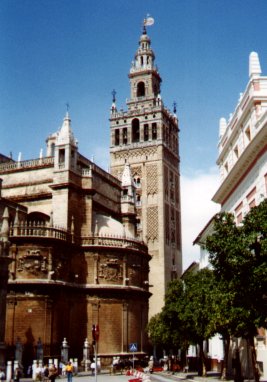Seville
Seville (Spanish: Sevilla) is the artistic, cultural, and financial capital of southern Spain, crossed by the river Guadalquivir. It is the capital of Andalusia and of the province of Sevilla. The inhabitants of the city are known as Sevillanos. As of the 2003 census, the population of the city of Seville proper was 709,975, and the population of the entire urban urban area was estimated in 2003 to be 1,294,081, ranking as the fourth-largest urban area of Spain.
History
Seville was named Ishbiliya under the Moors and Hispalis under the Romans. Legend has it that it was founded by the equally legendary Greek hero, Hercules. Historians believe it was founded by the Tartessos in the 8th or 9th century BCE. Later it was occupied by the Phoenicians and the Carthaginians, who destroyed the city in 216 BCE. In 206 BCE, Scipio Africanus founded Italica nearby and began the reconstruction of Hispalis. The architecture of the older parts of the city still reflects the centuries of Moorish control of the city.
The city was long an important sea port, prior to the silting up of the Guadalquivir. It sits well inland, but a mere 6 meters above sea level. Much of the Spanish Empire's treasures from the New World came to Europe via Seville, and Seville still holds the most important archive of the Spanish conquests in the Americas.
It was the home of Expo 92 World's Fair. The showpiece bridge across the Guadalquivir was designed by renowned architect Santiago Calatrava was built for this occasion. Seville also hosted the European Summit in June 2002; this was met with a counter-summit by those opposing neoliberalism and the tightening of European regulations on immigration.
Seville is known for its hot summer weather, reaching even 47 degrees Celsius in the hottest days of the summer.
Renowned People Born in Seville
- Roman emperors Trajan and Hadrian were born in Italica, near Hispalis
- Baroque painters Velázquez and Murillo
- Romantic poet Gustavo Adolfo Bécquer
- 20th century poets Vicente Aleixandre (Nobel Laureate), Antonio Machado and Luis Cernuda
- actress Carmen Sevilla
- singer Isabel Pantoja
Sights
The city's great Cathedral was built from 1401 - 1519 after the Reconquista on the former site of the city's mosque. The interior is lavishly decorated, with a large quantity of gold evident. The Cathedral reused some columns and elements from the old mosque, and most famously the Giralda, originally a minaret, was converted into a bell tower. It is topped with a statue representing Faith. The Giralda is the city's most famous symbol.
The Alcazar is the city's old Moorish Palace; construction was begun in 1181. Additional construction continued for over 500 years.
The Parque Maria Luisa was built for the 1929 Exposición Ibero-Americana World's Fair, and now is landscaped with attractive monuments and museums.
Education
Sports
Home town of two rival soccer teams Sevilla FC and Real Betis Balompié.
Seville hosted the 7th Athletics World Championships in 1999.
Motto
The motto of Seville is "NO8DO". The "8" is shaped like a wool hank, in Spanish madeja. This makes the motto, as a rebus read "NO madeja DO" which is a pun on "no me ha dejado" = "she did not abandon me". This refers to the city's support for King Alphonse X in the war with his son Don Sancho in the 13th century. This motto is seen throughout Seville, inscribed on manhole covers.
Seville in fiction
- Seville hosts the legend of Don Juan
- Seville is the primary setting of Bizet's opera Carmen, and also of Rossini's opera The Barber of Seville
- Seville is the setting of the novel and film Nadie conoce a nadie, which incorporates the elaborate Sevillian processions during Holy Week.
- The Plaza de España in the Parque Maria Luisa appears in George Lucas' Star Wars Episode II: Attack of the Clones.
Photos
File:SevillaPuenteTrianaNoche.jpg
Night view of Bridge of Triana from Betis street.

view of Seville from the Giralda tower next to the cathedral.
External links
- City councils (in Spanish only)
Seville is also the name of a place in the U.S. state of Ohio: see Seville, Ohio Seville is also the name of an automobile model: see Cadillac Seville



